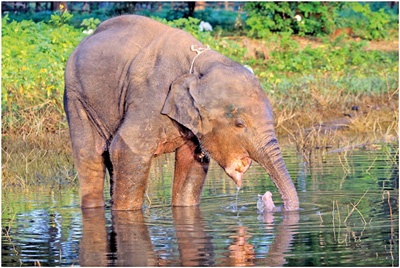By Malaka Rodrigo
Playful baby elephants were half of casualties
The female elephant calf was thirsty. Standing in the shallows of a water hole at dusk, it hurriedly sucked water into its trunk. It then curled its little trunk toward its mouth in an attempt to quench its thirst but there wasn’t a proper mouth to take in the trunk: the calf had lost his tongue; the small, fleshy base of what used be his tongue made a futile effort to guide the water down his throat.

The three-year-old elephant’s upper mouth palate had been totally smashed, creating a large wound that was infected. Its jaw and teeth were all blasted and the torn lower lip was rotting, attracting swarms of flies.
This has been the sad plight of victims of the little jaw bombs – illegal improvised explosive devices often hidden in food to explode in mouth when an unwary animal munches them. The bombs are commonly called hakka patas – hakkameaning jaw and patas denoting the sound of a blast.
The veterinary surgeon and team of the Department of Wildlife Conservation’s (DWC) Central Wildlife Region rushed to Nildandahinna area in Walapane after villagers told them about the injured calf.
They found it standing on the bank of the Uma Oya, sedated it, cleaned its mouth and provided saline as the suffering animal was weak: it was unable to eat or drink.
The vet, Dr. Akalanka Pinidiya, also injected strong antibiotics against infection in the injuries but he clearly knew the elephant would not survive its wounds.
“It is actually nearly impossible to successfully treat a hakka patas victim,” Dr. Tharaka Prasad, who heads the DWC’s veterinary unit said. “Our veterinary surgeons are helpless in most cases and can just employ painkillers until certain death ends the victim’s agony.”
The Anuradhapura wildlife range is one of the worst hotspots for hakka patas. The veterinary surgeon in charge of the range, Dr. Chandana Jayasinghe, said he had encountered hundreds of hakka patas victims during his 15 years of service.
“We saved the lives of only a handful of hakka patas victims, those that had minor injuries,” Dr. Jayasinghe said.
Hakka patas are a relatively new threat to Sri Lanka’s dwindling elephant population, with the first victims recorded around 2008.
The improvised device is made by mixing gunpowder with tightly-packed small stones or other hard materials. A chewing motion makes the hard bits grind against each other and set off sparks that ignite the gunpowder.
Because the device is tightly packed the pressure makes an explosion. This explosion is usually powerful enough to kill its main target, wild boar, but larger animals such as elephants do not die instantly.

Hakka patas became the main cause of elephant deaths in 2017 and 2018, overtaking the deaths by gunshot wounds. In 2019, out of a total of 395 elephants killed, hakka patasdeaths were high as 67, only four fatalities short of the 71 gunshot deaths.
Data from the wildlife department shows a sharp decrease in elephants dying from gunshots in 2010-2013 and a sharp increase of hakka patas mortalities during the same period. These deaths have kept increasing.
Last year, 67 elephants fell victims to hakka patas and, tragically, half – 35 – were less than 10 years old.
Hakka patas deaths are the main cause of deaths for elephants less than five years of age: 14 baby elephants less than five years were victims of hakka patas last year, 13 of them being male. Elephant experts point out that male elephant babies are more playful and curious about their surroundings.
In 2016, a 10-year-old boy in Hambegamuwa died when a hakka patas exploded in his mouth. On several other occasions, children playing with hakka patas laid for animals suffered injuries when the devices exploded.
It is not easy to apprehend the culprits who set these explosive devices, DWC Director-General Chandana Sooriyabandara said.
“When an animal is killed using a gun or poison, poachers leave some traces but in case of these explosive devices, it is extremely difficult to trace culprits as the victims are often found in a different area from where the devices were placed,” Mr. Sooriyabandara said.
Also, unlike when using a gun, it is easier for offenders to hide or throw away these little devices when they encounter law enforcement officers, he added.

Elephant researcher Dr. Prithviraj Fernando stressed that the issue must be addressed both from elephant conservation and anti-poaching angles since these devices are mainly set up for wild boar.
“The only way to address the issue is to use peer pressure to try to stop poachers from using this inhumane killing method,” Dr. Fernando said.
The Centre for Environmental Justice conducts a number of awareness campaigns in hakka patas hotspots for schoolchildren, using temples as venues, to raise awareness of the agony of deaths caused by these disguised explosives.
Experts say the problem could be alleviated by using intelligence networks in villages. Hakka patascannot be made by everybody: there is a technique to making them and only a few people in a village would have the skills; most often, other villagers know who is responsible.
It is suggested that police or the Civil Defence Force to be authorised to set up such intelligence networks.
[This report was produced under the CIR Investigative Journalism Fellowship Program 2019/2020]



